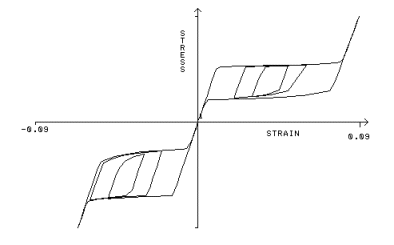Shape-memory-alloys (SMA) such as Nitinol exhibit the superelastic effect. The term superelastic is used to describe materials with the ability to undergo large deformations in loading-unloading cycles without showing permanent deformations.
Under loading-unloading cycles, even up to 10-15% strains, the nitinol material shows a hysteretic response, a stiff-soft-stiff path for both loading and unloading, and no permanent deformation.
The Nitinol material model is available for solid and shell elements.
 |
| A typical stress-strain response for a Nitinol bar under uniaxial loading conditions. Note that the material behaves differently in tension and compression
|
The stress-strain curve of shape-memory-alloys demonstrate a distinctive macroscopic behavior, not present in traditional materials. This behavior is attributed to the underlying macro-mechanics. SMA present reversible martensitic phase transformations, that is, a solid-solid diffusion-less transformations between a crystallographically more-ordered phase, “austenite”, and a crystallographically less-ordered phase, “martensite”.
The soft portions of the response curve represent the areas where a phase transformation: a conversion of austenite into martensite (loading), and martensite into austenite (unloading) occurs.
For the sake of simplicity, however, we will refer to the soft behavior on the response curve as “plastic”, and to the stiff portions as “elastic”.
According to this definition, the material first behaves elastically until a certain stress level is reached (the initial yield stress in loading). If the loading continues, the material shows an elastoplastic behavior until the plastic strain reaches its ultimate value. From this point onward, the material behaves elastically again under increased loads.
For unloading, again the material always starts to unload elastically until the stress is reduced to the initial yield stress in unloading. The material will then unload in an elastoplastic manner until all the accumulated plastic strain (from the loading phase) is lost. And from that point onward, the material will unload elastically until it returns to its original shape (no permanent deformation) and zero stress under zero loads.